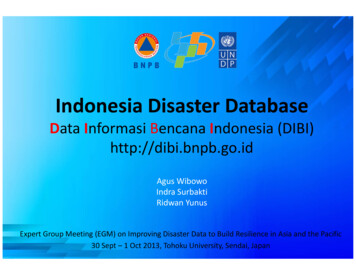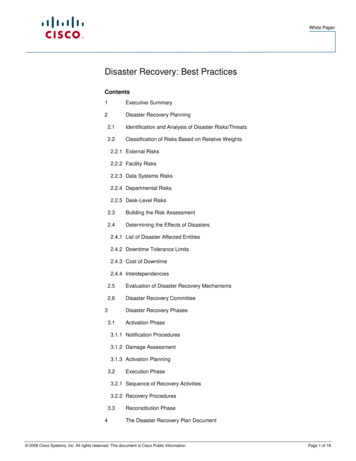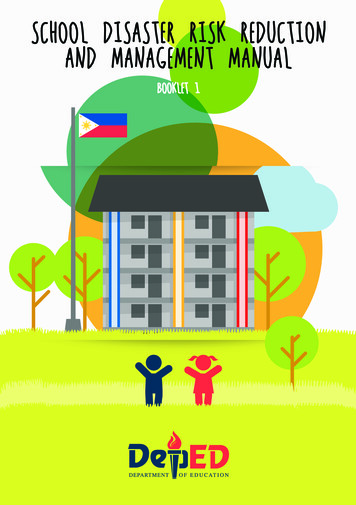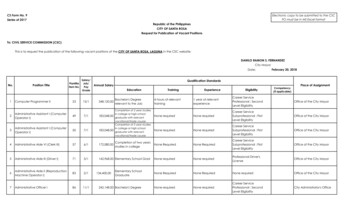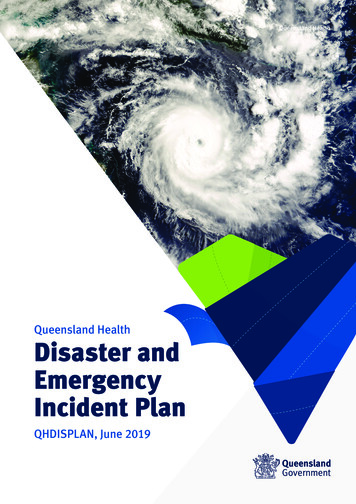
Transcription
GOVERNMENT OF KENYAMINISTRY OF STATE FOR SPECIAL PROGRAMMESOFFICE OF THE PRESIDENTNATIONAL POLICYFORDISASTER MANAGEMENT IN KENYAMARCH, 2009
LIST OF UNCCDUNFCCCArid and Semi Arid LandsAfrica UnionConvention on Biological DiversityCommunity Based OrganizationsConflict Early Warning and Response NetworkCivil Society OrganisationsDisaster ManagementDisaster Risk ReductionEconomic Community of West African StatesEarly Warning SystemGreater Horn of AfricaGeo Livelihood Review TeamsHuman Immune Virus/ Acquired Immuno-DeficiencySyndromeIntergovernmental Authority for DevelopmentInter-governmental Panel on Climate ChangeInternational Strategy for Disaster ResponseKenya Food Security MeetingKenya Food Security Steering GroupMonitoring and EvaluationInternational Convention for Prevention of Pollution fromShipsMillennium Development GoalsMetric TonnesMedium Term Expenditure FrameworkNational Disaster Management AgencyNon-Governmental OrganizationsNational Oceanic and Atmospheric AdministrationPrior Informed ConsentPersistent Organic PollutantsPoverty Reduction Strategy PaperConvention on Wetlands of International ImportanceSouthern African Development CommunityStandard Operating ProcedureUnited NationsUnited Nations Convention on Biological DiversityUnited Nations Convention to Combat DesertificationUnited Nations Framework Convention on Climate Change2
Definitions of Disaster Management TermsA Hazard: A hazard is a dangerous phenomenon, substance, human activity orcondition that may cause the loss of life, injury or other health impacts, propertydamage, loss of livelihoods and services, social and economic disruption, orenvironmental damage.A Natural Hazard: Natural processes or phenomenon that may cause loss oflife, injury or other health impacts, property damage, loss of livelihoods andservices, social and economic disruption, or environmental damage.A Geological Hazard: Geological process or phenomenon that may cause loloss of life, injury or other health impacts, property damage, loss of livelihoodsand services, social and economic disruption, or environmental damage.A Technological Hazard: A hazard originating from technological or industrialconditions, including accidents, dangerous procedures, infrastructure failures orspecific human activities, that may cause loss of life, injury, illness or otherhealth impacts, property damage, loss of livelihoods and services, social andeconomic disruption, or environmental damage.A Disaster: A disaster is a serious disruption of the functioning of a communityor society causing widespread human, material, economic or environmentalloses which exceed the ability of the affected community/society to cope usingits own resources.A Disaster Risk: The potential disaster losses, in lives, health status,livelihoods, assets and services, which could occur to a particular community ora society over some specified future time period.Disaster Risk Management: The systematic process of using administrativedirectives, organisations, and operational skills and capacities to implementstrategies, policies and improved coping capacities in order to lessen theadverse impacts of hazards and the possibility of disaster.Disaster Risk Reduction: he concept and practice of reducing disaster risksthrough systematic efforts to analyze and manage the causal factors ofdisasters, including through reduced exposure to hazards, lessenedvulnerability of people and property, wise management of land and theenvironment, and improved preparedness for adverse events.Risk Assessment: A methodology to determine the nature and extent of riskby analyzing potential hazards and evaluating existing conditions ofvulnerability that together could potentially harm exposed people, property,services, livelihoods and the environment on which they depend.3
Climate Change: A change in the state of the climate that can be identified(e.g. by using statistical tests) by changes in the mean and/or the variabilities ofits properties and that persist for an extended period, typically decades orlonger. Climate Change may be due to natural internal processes or externalforcings or to persistent anthropogenic changes in the composition of theatmosphere or land use.Adaptation to Climate Change: The adjustment in natural or human activitiesin responses to actual or expected climate stimuli or their effects whichmoderate harm or exploit beneficial opportunities.Vulnerability: The characteristics and circumstances of a community, systemor asset that makes it susceptible to the damaging effects of a hazard.4
FOREWORDKenya’s disaster profile is dominated by droughts, fire, floods, terrorism,technological accidents, diseases and epidemics that disrupt people’slivelihoods, destroy the infrastructure, divert planned use of resources, interrupteconomic activities and retard development. In the pursuit of reducingvulnerabilities to risks, the Government has formulated this National Policy onDisaster Management to institutionalise mechanisms for addressing disasters.Recent disaster events, the successive Reports of the Inter-governmentalPanel Climate Change (IPCC), the recent Climate Change Conference (Nairobi, Nov. 2006), and a recent comprehensive environmental reconnaissancesurvey over the whole country have all stressed the central role of ClimateChange in any sustainable planned and integrated National Strategy forDisaster Management.The policy emphasizes preparedness on the part of the Government,communities and other stakeholders in Disaster Risk Reduction activities. Inthis regard, the policy aims at the establishment and strengthening of DisasterManagement institutions, partnerships, networking and main streamingDisaster Risk Reduction in the development process so as to strengthen theresilience of vulnerable groups to cope with potential disasters. Ministry of Statefor Special Programmes in the Office of President will coordinate Disaster RiskReduction initiatives within a unified policy framework in a proactive manner atall levels.Disaster Risk Management encompasses a full continuum from preparedness,relief and rehabilitation, mitigation and prevention. The Policy aims to increaseand sustain resilience of vulnerable communities to hazards throughdiversification of their livelihoods and coping mechanisms. This entails a shiftfrom the short term relief responses to development. The Policy will go a longway in preserving life and minimising suffering by providing sufficient and timelyearly warning information on potential hazards that may result to disasters. Itwill also aim at alleviating suffering by providing timely and appropriateresponse mechanisms for disaster victims.The preparation of this Policy Paper has benefited from invaluable contributionfrom experts in various Ministries and organizations and it is hoped that the fullimplementation of this Policy will contribute immensely to disaster riskreduction, effective disaster preparedness, response, recovery andreconstruction as well as contribute to poverty reduction and sustainabledevelopment in the country, particularly among those communities that havebeen identified as highly vulnerable to disaster risk, loss of life and livelihoods.HON DR. NAOMI SHAABAN, EGH, MPMINISTER OF STATE FOR SPECIAL PROGRAMMES5
ACKNOWLEDGEMENTSThe conceptual need to formulate a comprehensive Disaster ManagementPolicy came to the fore about ten years ago; and many successive effortsfollowed with foundation documents, which were thereafter utilised in theresearch to formulate a concrete Disaster Management Policy document.Subsequently, particularly over the last nearly three years, starting October2006, the process research for formulation of the Disaster Management policyfor Kenya has been a collaborative, contributory process involving manyparties, the Government, Development Partners and stakeholders at all levels,National, District and lower levels. In particular, the Ministry of SpecialProgrammes is indebted to the consultants, Ministries, stakeholders, andpersonalities who laid down the foundation of the Disaster Management policyreview, by the Draft Policy Document of April 2007. That Document is the basisof subsequent workshops and fieldwork for the draft Disaster ManagementPolicy Review.The Ministry, set up a Disaster Management Policy Review Committee, inNovember 2008, made up of a Consultant, and five Committee members.Thereafter, a further five members were incorporated, including a Facilitatorand two Rapporteurs. This team, in partnership with various DevelopmentPartners and stakeholders, held successive, analytical and technical workshopsof various sizes and durations, to facilitate an effective review, from November2008 to February 2009. The dutiful and committed application of there effortsand that of partners and stakeholders is particularly appreciated by the Ministry,for, without it, this document would not be a reality.Lastly, innumerable Kenyan personalities from the Universities, Researchinstitutes, as well as International organisations (including UN agencies, Oxfam,the European Union) are especially thanked for their invaluable contributionstoward the review of the Draft Disaster Management Policy.ALI D. MOHAMMEDPERMANENT SECRETARYMINISTRY OF SPECIAL PROGRAMMES6
EXECUTIVE SUMMARYIn the last two decades, Kenya has continued to face a rising degree ofvulnerability to disaster risk due to increased diversity, frequency of occurrenceand intensity of impacts over time and space. This risk is the probability of ahazard turning into a disaster, with households or communities being affectedin such a manner that their lives and livelihoods are seriously disrupted beyondtheir capacity to cope or withstand using their own resources. As a resultaffected populations suffer serious widespread human, material, economic orenvironmental losses. Communities in Kenya are predisposed to disasters by acombination of factors such as poverty, aridity, settlement in areas prone toperennial flooding or areas with poor infrastructure and services such as theinformal urban settlements or even living in poorly constructed buildings.These factors, coupled with naturally occurring hazards such as droughts,floods, HIV and AIDS, landslides and epidemic outbreaks are currentlyexacerbated by Climate Change phenomena, pose extremely high andincreasing disaster risks to the Kenyan society. In addition, there is a widerange of emerging disasters.High population growth rate and poverty increase vulnerability to disasters.According to the Ministry of Planning and National Development, Kenya’spopulation rose to 38.6 million towards the end of 2008 and is estimated to hitthe 40 million mark by 2010. This population, growing at the rate of 2.7% andlargely youthful (60% of the population is aged under 25 years), is bound to beadversely affected, particularly with the high poverty rates (46% of Kenyans livebelow the poverty line), unemployment, the HIV and AIDS scourge and aneconomy largely dependent on rain-fed agriculture. As such this populationmay be classified as highly vulnerable to disaster since any small predisposingfactor may result in an emergency of high proportion, often culminating in anational disaster that requires external assistance.Despite economic, social and political vulnerability of this country, Kenya, so fardoes not have a comprehensive disaster management framework and strategy,which could guide appropriate policy and legislative provisions. While thecountry has so far managed to respond to the disasters as they occur, the costimplications cannot be ignored anymore. For example, the 1999-2001 drought,considered to be one of the worst droughts in the last 100 years, affected 4.5million people, decimated nearly 60-70% of livestock in the Arid and Semi Aridareas, caused crop failure in most parts of the Rift Valley, Coast, Eastern andCentral Provinces, which resulted in substantial agricultural and industriallosses that costed the nation billions of shillings.It is estimated that the Government, together with relevant stakeholdersincluding both humanitarian and development partners spent a colossal USD340 million to respond to this drought. A study entitled, “the cost of delayed7
response” carried out by disaster management experts in 2002 estimated thatonly USD 171million was required to effectively respond to this drought hadthere been an effective disaster management system in place. The extraamount was a cost to the national economy attributed to poor preparednessand delayed response to this drought episode. This clearly indicates thatdisaster response is more expensive in comparison to management.In addition, among emerging disasters, a study is yet to be conducted on thetotal value of what was lost in the post election violence that followed 2007presidential elections.In view of the above realities, and based on worsening desertification and otherimpacts of Climate Change, the Government recognizes the need to establishan institutional, policy and legal framework to effectively manage the full cycleof disasters in general. This policy, whose formulation has been reviewed anddrafted many times in the last 15 years, is the final product of a comprehensiveparticipatory process involving various segments of our society and hasreceived inputs from different geographical regions.The document contains six chapters that provide background information ondisaster patterns and profiles in Kenya including existing categories.Justification summarizes the existing initiatives for Disaster Management, andthe consequent problems and challenges. The Systematic Approach givesguidelines and principles for effective disaster management and Code ofConduct expected of different stakeholders involved in disaster management inKenya. It provides for enactment by Parliament for a legislative provision foreffective Disaster Management by establishment of an institutional frameworkthat is legally recognized and embedded within the Government structures.Innovative ways of mobilizing resources, managing them and accounting forthem properly have also been provided for, together with a rigorous monitoringand evaluation framework not only to monitor the progress in theimplementation of this policy, but also to undertake regular disaster risk profilingand monitoring in order to be more prepared for disasters.8
TABLE OF CONTENTSList Of AbbreviationsDefinitions of Disaster Management TermsFOREWORDACKNOWLEDGEMENTSEXECUTIVE SUMMARYCHAPTER 1: INTRODUCTION1.1 Background1.2 Classification of Disasters1.3 Dynamic Nature of Disasters and their Impact1.4 Collaboration of Stakeholders in Disaster Management235671010141415CHAPTER 2: CURRENT DISASTER MANAGEMENT INITIATIVES2.1 Strengths and Opportunities Within Current DM System2.2 Challenges of the Current DM System & Lessons Learned17CHAPTER 3: SYSTEMATIC APPROACH TO DM3.1 Features Of An Effective Disaster Management System3.2. Goals and Objectives3.3 Relationship of DM Policy to Other Policies & Legislations3.4 Guiding Principles3.5 Code of Conduct222225282931CHAPTER 4: POLICY, LEGAL & INSTITUTIONAL ARRANGEMENTS4.1 Enactment of the National Disaster Management Policy4.2 The Legal Framework4.3 Organisational Structure4.4 Existing Disaster Management Institutions4.5 The Role of the Existing Institutional Structures under the New Policy343434344242CHAPTER 5: RESOURCE MOBILIZATION, MANAGEMENT& ACCOUNTABILITY5.1 The key funds5.2Human and Non-human Resources5.3Logistical Arrangements5.4Infrastructure4646474748CHAPTER 6: MONITORING, EVALUATION AND RESEARCH6.1Monitoring6.2Evaluation6.3 Research6.4 Further Aspects of the Disaster Mnagement Systemfor Monitoring andEvaluation6.5 Sharing and Leaning Through Knowledge and Management17184950515252579
CHAPTER 1: INTRODUCTION1.1 BACKGROUNDOver the years, Kenya has been exposed to a variety of disasters such as,fires, droughts, floods, landslides, HIV/AIDS, human conflicts, drug abuse,traffic accidents, oil spill, industrial accidents and terrorism, among others.Kenya, like many other countries in Africa and elsewhere in the world hasexperienced an increase in the diversity, intensity and frequency of occurrenceof disasters over the past two decades, with many emerging disasters, such ascorruption. In many cases these have resulted in an increase in the number ofpeople affected and property damaged leading to rising economic losses.Disaster response reviews have indicated that response costs the governmentand other stakeholders more than would otherwise be the case if sufficientefforts had been put in place for effective disaster management as shown fromthe cost of responding to drought in the year1999-2001. This drought isestimated to have cost the government and other stakeholders 21.76 BillionKenya Shillings, a case in which only half of this amount would have been usedhad there been an effective DM system in place.As per the attached table drought, HIV/Aids, fires, civil and political conflictsand floods have the highest occurrence frequency and affect a large number ofpeople and their livelihoods. This notwithstanding the occurrence of otherdisasters both slow and rapid-onset such as diseases, road, landslides, foodpoisoning, terrorist attacks have occurred from time to time causing devastatingnegative impacts on communities. In addition of concern in the recent past arethe emerging disasters such as invasive plants as the hyacinth and the‘propasis juliflora’ (Mathenge). Others include drug & substance abuse as wellas child and human trafficking.Table1: Some of the Disaster Occurrences in Kenya 1974- 2009YEAR2009HAZARD/DISASTERFatal road accidentFire out-breaksAREAS COVEREDNairobi-Nakuru road, WoteMachakos road, ThikaNairobi road, Isiolo-MeruhighwayNakumat Down Townsupermarket-Nairobi,Sachangwan oil Tanker-RiftValley,Tuskys SupermarketEmbakasi, Gigiri VillaFranca, Mukuru Slums, TiwiResort club Mombasa,Huruma estate, Kibira MatchMaster Factory, DonhormESTIMATED CASUALTIES- 34 dead-More than 120 deadProperty worthMillions destroyed10
2008Drought and FaminePost election violenceFire outbreakFire outbreakSkirmishesCholera outbreak-Post election violenceCivil conflictsMombasaTaita Taveta districtSiaya/SubaKisumu/Kakamega RoadNyandike, Suba, Rongwe,MbitaKisumu NyanzaMolo area - NakuruFire incidentElburgon-Flash floodsMarsabit, Laisamis areaFire incidentLibra House in NairobiDroughtFood poisoning (aflatoxin)FloodsWidespreadMachakos, Makueni andKituiWidespreadMeasles outbreakAir-crashCountrywideMarsabitFloodsWater borne diseasesRoad accidentGas cylinder leakDrowning incidentMudslidesCattle rustling2006-Nyanza, western, NEP,Wajir district, Migori, Suba,Homa Bay, Siaya, Bondo,Kisii, Naivasha & NkuOver 20 districtsRift valleyMwingi, Rift valley, Maimahiu, NEPRift valley, Kitale, Transzoia,Makueni, Mwala/Kibwezi,BundalangiBungoma West districtWestern province, Narok,Kitui Machakos road,Kakuma Longirima road &Eldoret Kitale road, Kericho,Mlolongo Athi-riverMwala, KituiPokot centralPokotArmy wormsPlane crashConflicts2007estate, Musokolo-BusiaNorth Rift, Eastern, CentralWhole countryMeru central districtNakuru national parkTrans-nzoia, Laikipia WestBoat CapsizedMudslidesCholera epidemicsFatal Road accidentSkirmishes( NO FIGURES )1020 dead200 acres of forest burnt90 acres gutted down52 killed and houses burntdown122 dead-Crops destroyed4 killed ( 2 MPs )19 Killed-24 killed2396 affected-11 killed33 killed---10 admitted in hospital10 people drowned11 killed16 killed200 goats, 245 sheep 147donkeys stolen2 navy officers dead3 dead10 died5 dead3 police officers dead4 Vehicles burned downLooting & burning of shops2 people killed5,000 displaced7 members of the familyburned beyond recognition4 people died3,500 people displaced11 workers died3 missing (unidentifiedbodies)12 deaths reported35 cases reported7 deaths reported3,500 people displaced41 deaths reported14 deaths reported3 survived11
Flash floodsFreak stormIsioloKisumu Municipality –Winam sub locationKacheliba and Alale Divisionin West PokotNairobi along Ronald NgalaStreet-3,000 people displaced500 people displaced-20 deaths reported70 cases reported14 people died197 people injuredWild fireRift Valley-Oil spillKipevu in Mombasa-StormMerti – Isiolo-Extensive environmental andecological damageNo human life lostSea pollution endangeringmarine lifeDamage to ecosystem4,000 people cut-off betweenIsiolo and Merti for 7 daysDroughtFood poisoningWidespreadKitui, Makueni andMachakosKyumbi village in MachakosdistrictTurbi village in MarsabitDistrictMeningitis outbreakCollapse building2005-Illicit brew (‘kumi kumi’)Conflicts/clashes/insecurityRoad accident2004Drought2004Food Poisoning Aflatoxin200420042004LeptospirosisLand SlidesFire20032002Aircraft CrashBomb Blast (Terrorist 1200120001999/2000Road AccidentRoad AccidentDerailment of a goods trainDroughtBachuma – Taita Tavetaalong Mombasa RoadWidespreadMakueni,Machakos, Kitui,Embu, Mbeere and ThikadistrictsBungomaNyeri/Othaya KihuriCity Hall, NairobiBusiaMombasa, KikambalaParadise HotelMeru Central, Murang’a,NandiNyanza, Busia, Tana RiverBasinKyanguli Boys (Machakos)Free Market (Uhuru Park –Nairobi)Kericho/Londiani roadRiver SabakiAthi RiverWidespread- 13 died- 66 cases reported.- 50 people killed- 10 blinded- 7 people killed in one night- 22 injured- 3,000 people displaced- 23 people died- 30 seriously injuredAbout 3 million people rendered inneed of relief aid for 8 months toMarch 2005*333 affected by the poisoning and 123people dead12 people dead and 859 affected5 people deadEntire 3rd floor and valuabledocuments and property worthKShs.70 million destroyed3 people dead and 10 injured15 people dead2,000 affected150,000 affected68 students burnt to death andproperty destroyedEntire market and property destroyedby fire76 people dead40 people dead25 people burnt to death by fire4.4 million people affected by famine12
19991999August 199819981998Road AccidentTrain AccidentBomb Blast (Terrorist Attack)Petrol Tanker – ExplosionFireVoi/Mtito AndeiTsavoNairobiKisumu/Busia roadBombolulu Girls (Coast)1997/19981995/96El Nino ry AccidentTrain Mtongwe channelMtito AndeiArid and Semi-Arid Districtsof North Eastern, Rift Valley,Eastern and CoastProvincesLamuNyanza/WesternContinuous and 9751974DroughtFireFloodFireBomb Blast (Terrorist Attack)DroughtDroughtTrain AccidentBomb Blast (Terrorist Attack)DroughtAir AccidentWidespreadNairobiNyanzaLamuNorfolk Hotel NairobiWidespreadWidespreadDarajaniOTC Bus Terminus NairobiWidespreadJKIANote:Source:-40 people dead32 people dead 358 injured214 people killed and 5,600 injured36 people dead25 students burnt to death anddormitory and property destroyed1.5million people affected1.41 million people affected270 people dead31 people dead and 207 injured1.5 million people affected20 people dead10,000 people affected7 per cent of the total adult populationand more 100,000 children under 5years infected by the virus 350 peopledying daily200,000 people affected10,000 people affected4,000 people affected4,000 people affected5 people dead and 75 injured40,000 people affected20,000 people affected50 people dead27 people dead16,000 people affected60 people dead* Estimated Population in need of emergency relief aid from August2004 to March 2005.Data from row seven from the top to 1990 fire in Lamu is from a 1992Government Disaster Preparedness Discussion Paper. National Disaster Operations Centre calendar of Disasters.13
1.2 CLASSIFICATION OF DISASTERSDisasters in Kenya that have occurred in recent years are from diversehazards, such as droughts, floods, fires, terrorism, collapsing buildings,accidents in the transport sector and disease/epidemics. Some of these haveslow-onset while others have rapid-onset characteristics.Disasters are generally classified into 2 major categories: Natural and humanmade as follows:1. Natural: Bush fires, epidemics on human beings and animals, pests oncrops, forests and livestock; geologic and climatic disasters (e.gdroughts, floods, landslides, cyclones, storm surges, coastal erosionsearthquakes, invasive plants.2. Human-made: Terrorism, Industrial accidents, fires, transport accidents,civil, resource-based and political conflicts, collapsed infrastructure, foodpoisoning, invasive plants, drug and substance abuse, human trafficking,industrial sabotage, environmental degradation and other emergingdisasters.These hazards that commonly affect Kenya can be broadly grouped into thefollowing clusters:1. Environmentally-triggered (Climate-related;- droughts, floods,storms landslides)2. Geologic disasters includes volcanic eruptions, Tsunamis,earthquakes,3. Human-made disasters such as socio- economic, technologicindustrial, human,4. Biologically triggered (epidemics i.e. disease, pests for human,livestock and crops and wildlife)Clustering hazards by a broad generic type serves to assist the duty bearers,those potentially affected by disasters and wider humanitarian community toorganise and coordinate effectively in addition it enables effective management,monitoring, and contingency planning.1.3 DYNAMIC NATURE OF DISASTERS, AND THEIR IMPACTSPopulation exposure and ability to respond to different hazards varies. Forexample, it is increasingly evident that where poverty is widespread and deep,people’s abilities to cope with disasters are constrained or limited and requiresgreater investment in the systems of managing disasters. As such, investmentin disaster management recognises the scale of vulnerability as fundamental inunderstanding and dealing with disasters. People living in informal settlements14
and the ASALs are particularly vulnerable.the incidence of poverty in the country.This vulnerability corresponds toAs a result of the dynamic nature of the environment and disasters, as well asnew approaches to disaster management, this policy recognizes the need toembrace new concepts such as Disaster Risk Reduction and climate change.Disaster Risk Reduction is the systematic process of application of policies,strategies and practices to minimise vulnerabilities and disaster risks throughpreparedness, prevention and mitigation of adverse impacts of hazards within acontext of sustainable development. The DRR approach has become aworldwide practice since the Hyogo Framework of Action (HFA) and thisapproach should be adopted by all sectoral ministries as the dominant efforttowards Disaster Management. DRR approach should be mainstreamed andintegrated into the strategies and operations of every sectoral ministry ratherthan being left to be implemented by one Ministry.Climate Change is a change of climate which is attributed directly or indirectlyto human activity (especially carbon-emitting industries, fossil fuels, anddeforestation) that alters the composition of the global atmosphere and which isin addition to natural climate variability observed over comparable time periods.On the other hand, climate change is the destabilisation of normal climaticprocesses by man-made activities resulting in shifts in climatic systems, zones,extreme climate events and disasters. This policy recognizes the need to learnresearch and adapt to the hazards emanating from Climate Change.1.4 COLLABORATION OF STAKEHOLDERS IN DISASTER MANAGEMENTGovernment will play a lead role in the strategic planning and management ofdisasters in participatory collaboration with development partners, internationalagencies, CSOs and other bodies. Government shall also play a key role toensure availability of the various resources for DM at all levels fromGovernment sources and partners.The contribution of these stakeholders in DM in Kenya has been invaluable andthe Government will continue to encourage this collaboration and partnershipsfor the purposes of realising synergies, providing linkages, promoting trust,goodwill and ownership of the Disaster Management system.To achieve the Millennium Development Goals (MDGs), respond to theprovisions of the Hyogo Framework for Action (HFA) and to contribute to theachievement of Kenya’s Vision 2030 for sustainable development, an effectiveDisaster Management system is important for creating a safe, resilient andsustainable society.15
This policy provides for an integrated and co-ordinated Disaster RiskManagement that focuses on preventing or reducing the risk of disasters,mitigating their severity, improves preparedness, rapid and effective responseto disasters and post-disaster recovery.16
CHAPTER 2: CURRENT DISASTER MANAGEMENT INITIATIVESIN KENYAThis section of the policy analyses the context of disaster management inKenya, discusses its strengths, opportunities, challenges and lessons learnt. Italso outlines the current goals and objectives of this policy.2.1STRENGTHS AND OPPORTUNITIESDISASTER MANAGEMENT SYSTEMWITHINTHECURRENTThere exists a partially spontaneous system, which has assisted theGovernment and its development partners (the UN system and other reliefagencies) to respond to disasters in the country, such as the 1999-2001droughts that affected more than 4.5 million Kenyans.The various initiatives which work in place of a coordinated system include thefollowing players and organisations: the Kenya Food Security Meeting (KFSM)/Kenya Food Security Steering Group (KFSSG) and the Arid Lands ResourceManagement Project (ALRMP). The demonstrable commitment andparticipation of a large number of stakeholders in the current disastermanagement efforts is an indication of the existing good-will to addressDisaster Management in the country.Other participants in disaster management include specialised departmentssuch as the National Di
A Hazard: A hazard is a dangerous phenomenon, substance, human activity or condition that may cause the loss of life, injury or other health impacts, property . personalities who laid down the foundation of the Disaster Management policy review, by the Draft Policy Document of April 2007. That Document is the basis

